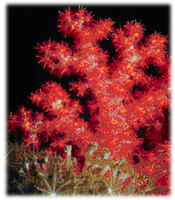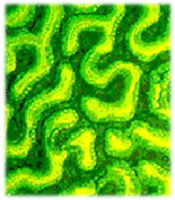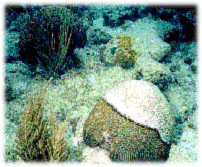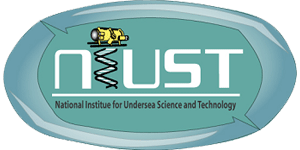 |
| Benthic invertebrates, like these
Pacific soft corals, have been a rich source of biotechnology
products. |
Biotechnology is defined as the industrial use of living organisms
or biological techniques developed through basic research; marine
biotechnology is an emerging discipline based on the use of marine
natural resources. The oceans encompass about 71% of the surface
of our planet, but over 99% of the biosphere (since organisms are
found throughout the water column), and they represent the greatest
extremes of temperature, light, and pressure encountered by life.
Adaptation to these harsh environments has led to a rich marine
bio- and genetic-diversity with potential biotechnological applications
related to drug discovery, environmental remediation, increasing
seafood supply and safety, and developing new resources and industrial
processes.
Drug Discovery and Marine-derived Compounds
 |
| Fluorescence in Bahamian brain
coral may provide novel biotech light sources. |
Drug discovery represents one of the most promising
and highly visible outcomes of marine biotechnology research. Biochemicals
produced by marine invertebrates, algae and bacteria, are very different
than those from related terrestrial organisms and thus offer great
potential as new classes of medicines. To date, examples of marine-derived
drugs include an antibiotic from a fungi, two closely related compounds
from a sponge that treat cancer and the herpes virus, and a neurotoxin
from a snail that has painkiller properties making it 10,000 times
more potent than morphine ithout the side effects. However, there
are several more marine-derived compounds currently in clinical
trials and it is likely that many more will advance to the clinic
as more scientists look to the sea for these biotechnological uses.
In addition to new medicines, other uses for marine-derived compounds
include: cosmetics (algae, crustacean and sea fan compounds), nutritional
supplements (algae and fish compounds), artificial bone (corals),
and industrial applications (fluorescent compounds from jellyfish,
novel glues from mussels, and heat resistant enzymes from deep-sea
bacteria).
Marine Biotechnology and Environmental Conservation
 |
| Coral diseases, such as Black Band Disease,
might be eradicated using new biotechnologies. |
Biotechnology also holds the promise of increasing food supplies
from the ocean; this is critical as overfishing and increased
demand have taxed the limits of marine sustainable stocks. Aquaculture
techniques have been enhanced by the discovery of natural inducers
for spawning and larval settlement, as well as remediation of
disease within culture facilities. Molecular genetic studies have
also been applied to fisheries to identify natural populations
and mixed stock interactions, and to estimate stocking efficiencies
with pedigree. More recently, biotechnology has been used to assess
seafood safety through the development of novel test kits that
react to the presence of human pathogens in the food. These "biosensor"
techniques are currently being employed as early warning systems
for environmental health. For example, harmful algal blooms and/or
anthropogenic toxins have the potential to cause great harm to
marine habitats. Unique biosensors are being developed to inform
scientists of increasing levels of specific biomarkers. Moreover,
specific marine bacteria have been developed that can aid in the
clean-up effort if a toxic spill should occur; thus biotechnology
not only helps society, but it helps the environment as well.
OBCR scientists are also applying their research techniques to
NOAA NURP priorities of coral disease management and marine environmental
health.
The Ocean Biotechnology Center and Repository
NOAA NURP and its partner the National Institute of Undersea Science
and Technology (NIUST) is committed to assessing the marine biotechnological
potential of US coral reef organisms. NIUST was founded in 2001
to address NOAA NURP research priorities that transcend the regional
boundaries of the NURC system. The Ocean Biotechnology Center
and Repository (OBCR), a division within NIUST, is housed within
the National Center for Natural Products Research located at the
University of Mississippi (Oxford MS). In the last 3 years, OBCR
has surveyed and sampled the marine resources of Hawaii, Alaska,
Puerto Rico, Guam, Saipan, and American Samoa. The repository
currently contains over 2000 extracts which have been tested in-house
for antibiotic, anticancer, and antimalarial activity. These extracts
have also been forwarded to academic and industrial partners across
the United States for additional screening. Over 10% of the repository
samples have been flagged for follow-up research efforts (this
compares favorably to the 0.5% "hit-rate" reported for
terrestrial plants by the NCNPR). In addition, this research increases
our understanding of novel marine organisms and habitats using
new and novel technologies.

|



